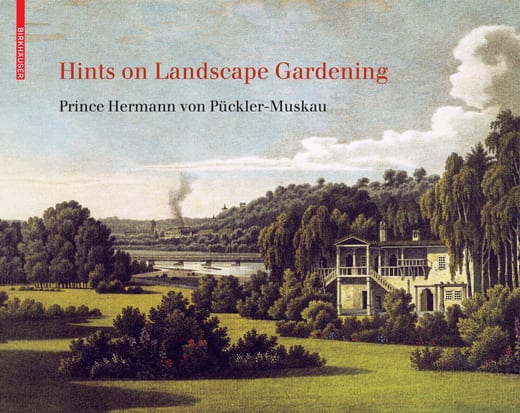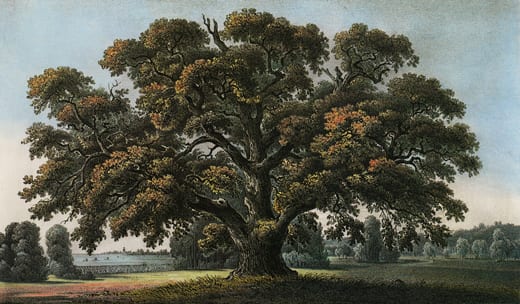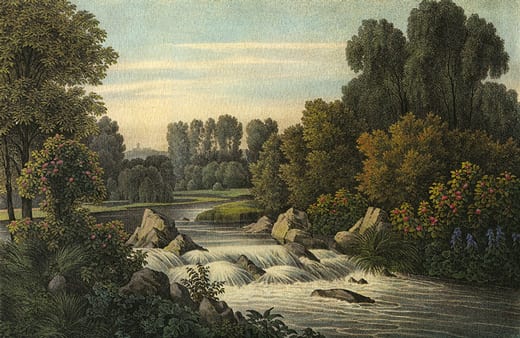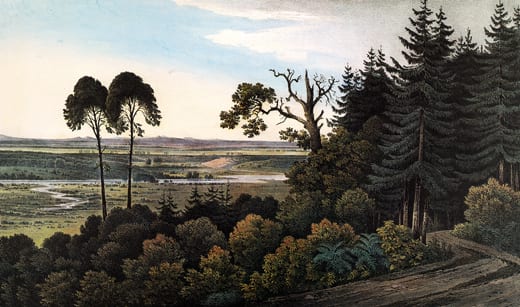HINTS FROM PRINCE PÜCKLER
A beautiful new edition of Hermann von Pückler-Muskau’s classic Hints on Landscape Gardening has just been released by Birkhäuser and the Foundation for Landscape Studies. The large-format volume includes the full set of lavish color prints originally published as a companion piece to the wry, highly opinionated text that took the landscape gardening world by storm in 1834.
A remarkably insightful new translation by John Hargraves–the first since the ASLA sponsored a reprint in 1917–is immeasurably enriched by Linda B. Parshall’s introduction and a nuanced preface by FLS president, Elizabeth Barlow Rogers, who illuminates philosophical resonances among Pückler, Frederick Law Olmsted, Calvert Vaux, and the great protector of Central Park, Samuel B. Parsons Jr.
(Scroll down to read it)

Preface by Elizabeth Barlow Rogers
It can be reasonably argued that Muskau Park and New York City’s Central Park are the apotheoses of mature Romanticism in landscape design. Although they are separated in time by nearly a generation, their respective designers, Prince Hermann von Pückler-Muskau and Frederick Law Olmsted, were alike in disregarding sentimental tropes and using unadorned nature as their principal source of inspiration. Their nineteenth-century Romanticism differed from that of their eighteenth-century forebears inasmuch as they did not conceive their parks as a series of programmatic itineraries—walks punctuated with monuments and artifacts intended to instruct the visitor or elicit memories and emotional responses. Instead, both Pückler and Olmsted sought by means of carriage roads and winding paths to carry the visitor though a sequence of scenes composed according to Picturesque principles. They felt that the materials of nature—turf, woods, and water—were sources of both spiritual nurture and aesthetic delight. Sweeping views and spatial breath informed their landscape compositions, which put a premium on broad meadows and borrowed views of open land and sky.
Although each was original in his approach, neither Pückler nor Olmsted forged a completely new idiom of landscape design; both of these mid-nineteenth-century place makers were well aware of the work and writings of eighteenth-century landscape designers and theorists. In Pückler’s case, these were the Goethe of Elective Affinities and C. C. L. Hirschfeld, the most important writer on gardens and landscape in late-eighteenth-century Germany, whose Theory of Garden Art had a significant influence on the subsequent development of European garden design and the establishment of public parks. In contrast, Olmsted as an Anglophone breathed the poetic air of Wordsworth and felt himself indebted to two eighteenth-century British writers on the Picturesque, Uvedale Price and William Gilpin. If not necessarily followers of Humphry Repton, both Pückler and Olmsted were cognizant of the design principles expounded in Repton’s famous Red Books.

In comparing Pückler and Olmsted, it is important to point out this critical distinction: Pückler was an aristocrat with sole control over a private domain, while Olmsted and his partner Calvert Vaux were the designers of America’s first purpose-built public park, a signal expression of democracy. But we should not make too much of this fact. Pückler was well aware of the forces galvanizing a revolutionary modernization of society and considered his work an exemplar not of an older way of life but rather a means of demonstrating to his fellow patricians a new kind of regard for their estates and tenants. In Hints on Landscape Gardening, he explains how, instead of sweeping away the local village as had been common in an earlier day when it might have been considered an eyesore, he made it and the fields tended by his vassals part of Muskau Park’s viewshed. He says, “To do this, it was only necessary to take what was already there and highlight and enrich it, without disturbing or distorting the locality or its history. Many Ultra-Liberals will smile at such an idea, but every form of human development is worthy of our respect, and since the one we are discussing is perhaps nearing its end, it has begun to take on a general, poetic, and romantic interest that can only be found with difficulty in factories, machines, and even constitutions.” (p. 177)
The old order was indeed at an end—it fact, it never existed in America—and had he read these words, Olmsted would have been in complete agreement. From its inception, Central Park was intended to serve as a counterbalance to industrial New York, a spiritual balm for residents of the teeming metropolis.

During the past forty years, Olmsted’s reputation has been elevated from that of a near-forgotten figure of a bygone era to one of revered founder of the profession of landscape architecture in America. Such has not been the case with Pückler. Olmsted himself would be the first to wonder at this oversight. Although he was probably not familiar with the Hints—first published in 1834 and first translated into French in 1847—when he and Vaux prepared their 1858 plan for Central Park, by 1883 he would advise his protégé Charles Eliot to visit the parks of Europe, especially those in Germany. Eliot traveled to Muskau, where he quickly grasped the genius of the park’s design.
Although, as in the case of Olmsted, Pückler’s status was eclipsed by twentieth-century modernism, his reputation did have a brief revival after Samuel Parsons visited Muskau in 1906. The successor to Olmsted and Vaux as the official landscape architect of the New York City Parks Department, Parsons was eager to transmit Pückler’s design principles to a new generation of American landscape professionals. He commissioned the first English translation of the Hints, which was published in 1917.[1] In his own book, The Art of Landscape Architecture,[2] published two years earlier, he went beyond mere homage, according Pückler even more authority than Olmsted. His book is, in fact, mainly a compendium of quotations from the Hints, and its chapter titles exactly follow Pückler’s. Further, more than a quarter of its forty-eight illustrations are of Muskau.

Today a century separates us from Parsons. The 1917 English translation of the Hints he commissioned is outdated and long out of print. Its illustrations are sparse and none are in color. We are therefore grateful to translator John Hargraves, who has made Pückler’s German text more accurate and accessible to the reader in English than heretofore and to Linda Parshall, whose insightful introduction is rich in biographical detail. We are also indebted to the Stiftung “Fürst-Pückler-Park Bad Muskau” for providing high-resolution scans of the colored lithographs that replicate the visual richness of the original atlas. The digital technology offered by our publishing partner, Birkhäuser, makes possible the production of this book in both print and electronic formats—a boon to many readers.
A book such as this necessarily requires support from several sources. The Foundation for Landscape Studies thanks the Graham Foundation as well as our generous individual donors for helping underwrite its development, editing, and design. We further thank Andreas Müller, editorial director of Birkhäuser, for his advice and guidance, and Birkhäuser’s publishing parent, De Gruyter, for ensuring that the book’s production values meet the highest standards in the trade.